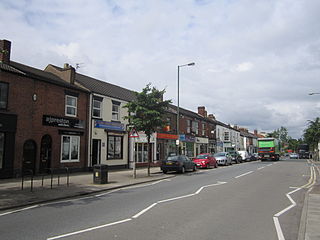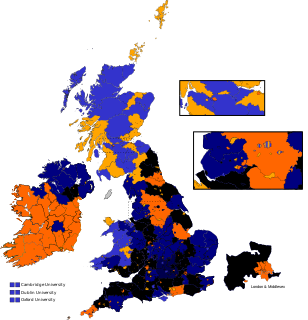
Lancashire is a county in North West England. Lancashire is a historic, ceremonial and non-metropolitan county and the county boundaries differ between these different forms. Its county town is Lancaster. The non-metropolitan county was created by the Local Government Act 1972 and is administered by the Lancashire County Council and twelve district councils. Its administrative centre is Preston. The ceremonial county has a population of 1,449,300 and an area of 1,189 square miles (3,080 km2).

Newton-le-Willows is a market town in the Metropolitan Borough of St Helens, in Merseyside, England. The population at the 2011 census was 22,114, incl. Newton-le-Willows is on the eastern edge of St Helens, south of Wigan and north of Warrington.

Ashton-in-Makerfield is a market town in Greater Manchester, England. It is part of the Metropolitan Borough of Wigan and is 4.2 miles (6.8 km) south of the town of Wigan. In 2001 it had a population of 28,505, increasing to 28,762 at the 2011 Census.

The Metropolitan Borough of Wigan is a metropolitan borough of Greater Manchester, in North West England. It is named after the main settlement of Wigan. It covers the towns of Atherton, Ashton-in-Makerfield, Golborne, Hindley, Ince-in-Makerfield, Leigh and Tyldesley. The borough also covers the villages and suburbs of Abram, Aspull, Astley, Bryn, Hindley Green, Lowton, Mosley Common, Orrell, Pemberton, Shevington, Standish, Winstanley and Worsley Mesnes. The borough is also the second-most populous district in Greater Manchester.

The Salford Hundred was one of the subdivisions of the historic county of Lancashire, in Northern England (see:Hundred. Its name alludes to its judicial centre being the township of Salford. It was also known as the Royal Manor of Salford and the Salford wapentake.

The West Derby Hundred is one of the six subdivisions of the historic county of Lancashire, in northern England. Its name alludes to its judicial centre being the township of West Derby.

Lancashire is a county of England, in the northwest of the country. The county did not exist in 1086, for the Domesday Book, and was apparently first created in 1182, making it one of the youngest of the traditional counties.

The Greater Manchester Built-up Area is an area of land defined by the Office for National Statistics (ONS), consisting of the large conurbation that encompasses the urban element of the city of Manchester and the metropolitan area that forms much of Greater Manchester in North West England. According to the United Kingdom Census 2011, the Greater Manchester Built-up Area has a population of 2,553,379 making it the second most populous conurbation in the United Kingdom after the Greater London Built-up Area. This was an increase of 14% from the population recorded at the United Kingdom Census 2001 of 2,240,230, when it was known as the Greater Manchester Urban Area.

The Manchester–Southport line is a railway line in the north-west of England, operated by Northern Trains. It was originally built as the Manchester and Southport Railway. Starting at the city centre stations of Manchester Victoria and Manchester Piccadilly, it runs in a north-western direction through the towns, villages and suburbs of the City of Salford and Bolton. It then proceeds in the same direction through the small rural villages of West Lancashire, before ending on the Irish Sea coast at the resort town of Southport.

Lancashire was a county constituency of the House of Commons of the Parliament of England from 1290, then of the Parliament of Great Britain from 1707 to 1800, and of the Parliament of the United Kingdom from 1801 to 1832. It was represented by two Members of Parliament, traditionally known as Knights of the Shire until 1832.

North Lancashire was a county constituency of the House of Commons of the Parliament of the United Kingdom. It was represented by two Members of Parliament. The constituency was created by the Great Reform Act of 1832 by the splitting of Lancashire constituency into Northern and Southern divisions.
South East Lancashire was a county constituency of the House of Commons of the Parliament of the United Kingdom. It was represented by two Members of Parliament. The constituency was created by the Reform act of 1867 by the splitting of the South Lancashire constituency into South-West and South-East divisions.

The High Sheriff of Lancashire is an ancient officer, now largely ceremonial, granted to Lancashire, a county in North West England. High Shrievalties are the oldest secular titles under the Crown, in England and Wales. The High Sheriff of Lancashire is the representative of the monarch in the county, and is the "Keeper of The Queen's Peace" in the county, executing judgements of the High Court through an Under Sheriff.
NHS North West was a strategic health authority (SHA) of the National Health Service in England. It operated in the North West region, which is coterminous with the local government office region.

The Lancashire County Rugby Football Union is the society responsible for rugby union in the county of Lancashire, England, and is one of the constituent bodies of the national Rugby Football Union having been formed in 1881. In addition it is the county that has won the County Championship on most occasions
The North West Men's League is a rugby league competition for clubs in the North West of England. It is a successor league for the Rugby League Conference also comprising clubs from the North West Counties League following most of the latter switching to summer to follow the National Conference League.














